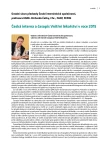Surprisingly old skeleton in the cupboard – editorial
Authors:
Petr Sucharda
Authors‘ workplace:
III. interní klinika 1. LF UK a VFN Praha, přednosta prof. MUDr. Štěpán Svačina, DrSc., MBA
Published in:
Vnitř Lék 2015; 61(1): 10-12
Category:
Editorials
Sources
1. Johnson RJ, Titte S, Cade JR et al. Uric acid, evolution and primitive cultures. Semin Nephrol 2005; 25(1): 3–8.
2. Koborová I, Kollárová R, Hlavatá A et al. Asymptomatická hyperurikémia a metabolický syndróm u mladistvých. Vnitř Lék 2015; 61(1): 42–49.
3. Grayson PC, Kim SY, LaValley M et al. Hyperuricemia and incident hypertension: A systematic review and meta-analysis. Arthritis Care Res (Hoboken) 2011; 63(1): 102–110.
4. Soletsky B, Feig DI. Uric acid reduction rectifies prehypertension in obese adolescents. Hypertension 2012; 60(5): 1148–1156.
5. Assadi F. Allopurinol enhances the blood pressure lowering effect of enalapril in children with hyperuricemic essential hypertension. J Nephrol 2014; 27(1): 51–56.
6. Whelton A. Hyperuricemia and hypertension. A confluence of concepts. Hypertension 2012; 60(5): 1112–1113.
7. Soltani Z, Rasheed K, Kapusta DR et al. Potential role of uric acid in metabolic syndrome, hypertension, kidney injury, and cardiovascular diseases: is it time for reappraisal? Curr Hypertens Rep 2013; 15(3): 175–181.
8. Johnson RJ, Sánchez-Lozada LG, Mazzali M et al. What are the key arguments against uric acid as a true risk factor for hypertension? Hypertension 2013; 61(5): 948–951.
9. Kanbay M, Solak Y, Gaipov A et al. Allopurinol as a kidney-protective, cardioprotective, and antihypertensive agent: hype or reality? Blood Purif 2014; 37(3): 172–178.
10. Enzi G, Busetto L, Inelmen EM et al. Historical perspective: visceral obesity and related comorbidity in Joannes Baptista Morgagni’s “De sedibus et causis morborum per anatomen indagata”. Int J Obes Relat Metab Disord 2003; 27(4): 534–535.
11. Reaven GM. Banting Lecture 1988. Role of insulin resistance in human disease. Diabetes 1988; 37(12): 1595–1607.
12. Alberti KG, Eckel RH, Grundy SM et al. International Diabetes Federation Task Force on Epidemiology and Prevention; National Heart, Lung, and Blood Institute; American Heart Association; World Heart Federation; International Atherosclerosis Society; International Association for the Study of Obesity. Harmonizing the metabolic syndrome: a joint interim statement of the International Diabetes Federation Task Force on Epidemiology and Prevention; National Heart, Lung, and Blood Institute; American Heart Association; World Heart Federation; International Atherosclerosis Society; and International Association for the Study of Obesity. Circulation 2009; 120(16): 1640–1645.
13. Sucharda P. Metabolický syndrom – kliniku patofyziologií nenahradíš. Practicus 2014; 13(4): 14–15.
14. Poyrazoglu S, Bas F, Darendeliler F. Metabolic syndrome in young people. Curr Opin Endocrinol Diabetes Obes 2014; 21(1): 56–63.
15. Zimmet P, Alberti G, Kaufman F et al. International Diabetes Federation Task Force on Epidemiology and Prevention of Diabetes. The metabolic syndrome in children and adolescents. Lancet 2007; 369(9579): 2059–2061.
16. Billiet L, Doaty S, Katz JD et al. Review of hyperuricemia as new marker for metabolic syndrome. ISRN Rheumatol 2014; 2014: 852954. Dostupné z DOI: <http://dx.doi.org/10.1155/2014/852954>.
17. Johnson RJ, Perez-Pozo SE, Sautin YY et al. Hypothesis: could excessive fructose intake and uric acid cause type 2 diabetes? Endocr Rev 2009; 30(1): 96–116.
18. Johnson RJ, Nakagawa T, Sanchez-Lozada LG et al. Sugar, uric acid, and the etiology of diabetes and obesity. Diabetes 2013; 62(10): 3307–3315.
19. Bray GA. Energy and fructose from beverages sweetened with sugar or high-fructose corn syrup pose a health risk for some people. Adv Nutr 2013; 4(2): 220–225.
20. Guthrie JF, Morton JF. Food sources of added sweeteners in the diets of Americans. J Am Diet Assoc 2000; 100(1): 43–51.
21. Stanhope KL, Schwarz JM, Keim NL et al. Consuming fructose-sweetened, not glucose-sweetened, beverages increases visceral adiposity and lipids and decreases insulin sensitivity in overweight/obese humans. J Clin Invest 2009; 119(5): 1322–1334.
22. Kratzer JT, Lanaspa MA, Murphy MN et al. Evolutionary history and metabolic insights of ancient mammalian uricases. Proc Natl Acad Sci USA 2014; 111(10): 3763–3768.
23. Watanabe S, Kang DH, Feng L et al. Uric acid, hominoid evolution, and the pathogenesis of salt-sensitivity. Hypertension 2002; 40(3): 355–360.
24. Feig DI, Kang DH, Johnson RJ. Uric acid and cardiovascular risk. N Engl J Med 2008; 359(17): 1811–1821.
Labels
Diabetology Endocrinology Internal medicineArticle was published in
Internal Medicine

2015 Issue 1
Most read in this issue
- Therapeutic monitoring of amikacin and gentamicin in routine clinical practice
- Association between asymptomatic hyperuricaemia and metabolic syndrome in the adolescents
- Tachycardia-induced cardiomyopathy
- The role of the assessment of heavy/light chain pairs of immunoglobulin in monoclonal gammopathies
